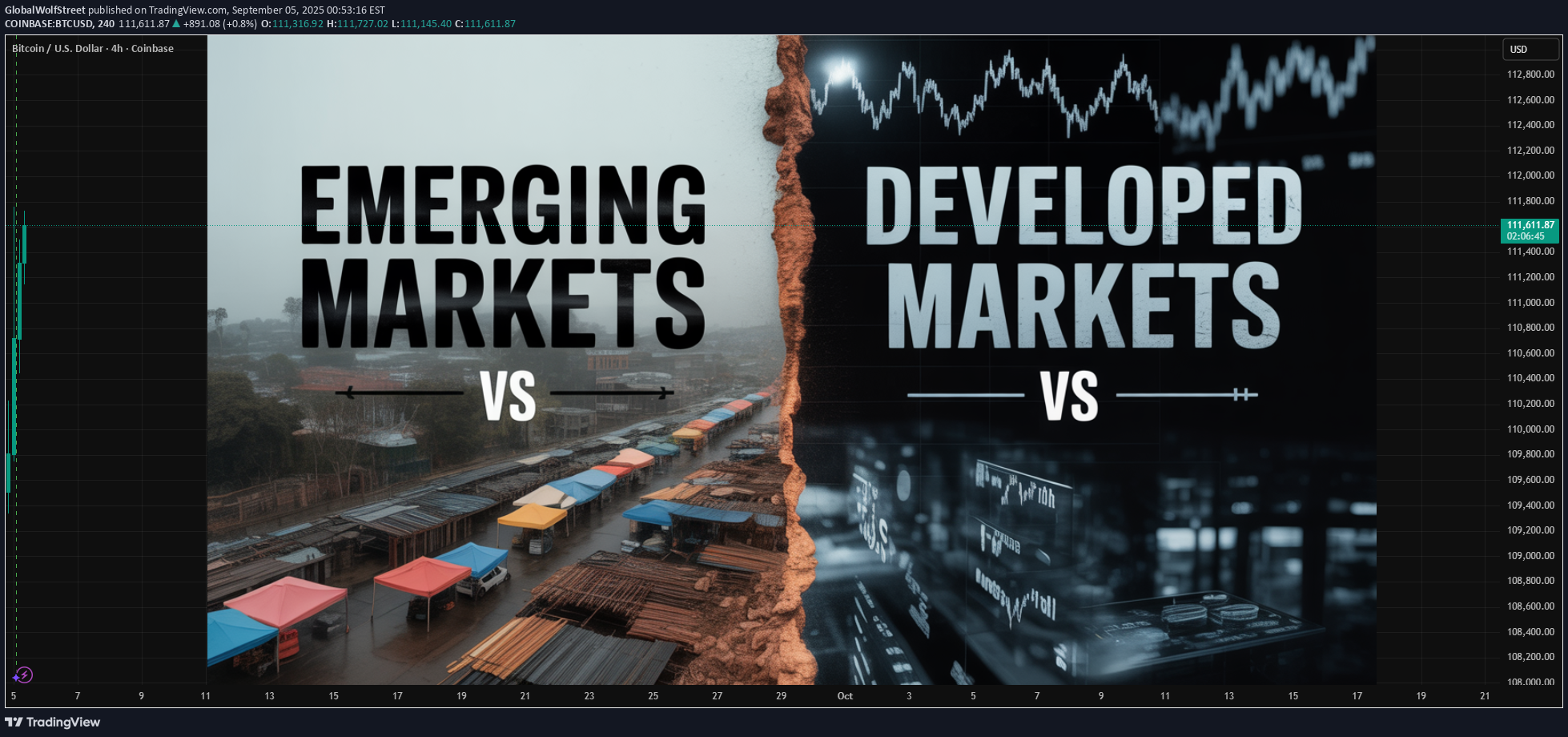05.09.2025 tarihinde sembol BTC hakkında Teknik GlobalWolfStreet analizi

1. Defining Emerging and Developed Markets Emerging Markets Defined by the World Bank, IMF, and MSCI as economies transitioning from low or middle-income to higher-income levels. Often characterized by rapid GDP growth, increasing foreign investment, and structural reforms. Have growing but still volatile financial markets. Examples: India, China, Brazil, Mexico, Turkey, South Africa. Developed Markets Countries with high per-capita income (usually above $12,000-$15,000), strong institutions, and advanced infrastructure. Financial systems are stable, liquid, and globally integrated. Economies are more service-oriented rather than manufacturing-driven. Examples: U.S., U.K., Germany, Japan, Canada, Australia. 2. Key Economic Characteristics FeatureEmerging MarketsDeveloped Markets GDP GrowthHigher growth rates (5–8% in many cases)Lower growth (1–3%) Per Capita IncomeLow to middle-incomeHigh-income Industrial StructureManufacturing & agriculture dominant, but services growingServices dominate (finance, technology, healthcare) InnovationCatching up; dependent on FDI & importsAdvanced R&D, global tech leaders Currency StabilityVolatile, prone to inflationStable, globally traded (USD, Euro, Yen) Emerging markets are often seen as growth stories, while developed markets represent stability and maturity. 3. Financial Market Differences Emerging Markets Stock markets are less liquid, meaning large trades can move prices dramatically. Higher volatility due to political risk, regulatory uncertainty, and global capital flows. Often more sector-concentrated (energy, banking, infrastructure). Foreign Direct Investment (FDI) plays a big role in financing growth. Developed Markets Deep, highly liquid capital markets (e.g., U.S. stock market is the largest in the world). Lower volatility, with strong institutional investors (pension funds, insurance companies). More diverse sectoral representation (tech, healthcare, finance, industrials). Better regulations, reducing systemic risks. 4. Investment Opportunities Why Investors Choose Emerging Markets Higher returns: Fast economic growth means higher equity and bond returns (though riskier). Demographics: Younger populations, rising middle class, and urbanization. Undervalued assets: Stocks and bonds often trade at cheaper valuations compared to developed markets. Natural resources: Many emerging economies are rich in oil, gas, and minerals. Why Investors Choose Developed Markets Stability: Political stability, strong legal protections, and reliable institutions. Liquidity: Easy entry and exit in large markets like the U.S. and Europe. Innovation hubs: Developed countries lead in technology, biotech, and finance. Lower risk: Investors prefer developed markets during global uncertainty. 5. Risk Factors Emerging Markets Risks Political Risk: Government instability, corruption, and inconsistent policy. Currency Risk: Devaluation or inflation affecting returns. Liquidity Risk: Difficulty in buying/selling assets without price disruptions. Regulatory Risk: Sudden changes in trade policy, taxes, or financial rules. Dependence on Commodities: Economies like Brazil or Russia depend heavily on oil/mineral exports. Developed Markets Risks Slower Growth: Returns are lower due to market maturity. Aging Population: Japan and Europe face demographic challenges. Debt Levels: High government debt (U.S., Japan). Global Linkages: Developed markets are highly exposed to global downturns. 6. Role in Global Trade Emerging Markets: Supply labor-intensive goods, commodities, and raw materials. They are key players in global manufacturing supply chains (China, Vietnam, India). Developed Markets: Supply high-value goods and services like technology, finance, pharmaceuticals, aerospace, and luxury products. Emerging economies are often the producers, while developed markets are the consumers and innovators. 7. Examples of Emerging vs Developed Markets Emerging Markets Examples India: Fastest-growing large economy, driven by services and IT. China: World’s factory, now transitioning toward consumption-driven growth. Brazil: Rich in natural resources but faces political and inflation challenges. South Africa: Gateway to Africa, but troubled by inequality and governance issues. Developed Markets Examples United States: World’s largest economy, innovation hub (Silicon Valley, Wall Street). Germany: Europe’s powerhouse, strong in engineering and manufacturing. Japan: Technology-driven, though aging demographics challenge growth. United Kingdom: Major financial center, diversified economy. 8. Performance Trends Emerging markets tend to outperform during global booms due to higher growth and demand for commodities. Developed markets perform better in downturns, as investors flock to safe assets. Over the last two decades, China and India have been the growth engines, while the U.S. has remained the financial powerhouse. 9. Case Study: 2008 Financial Crisis vs COVID-19 Pandemic 2008 Crisis: Developed markets (U.S., Europe) were hit hardest due to financial exposure. Emerging markets recovered faster, supported by China’s stimulus. COVID-19 Pandemic: Emerging markets struggled due to weak healthcare and high debt, while developed economies used fiscal stimulus and central banks to stabilize markets. This highlights how resilience differs across categories. 10. Future Outlook Emerging Markets: Expected to drive global growth due to demographics, urbanization, and technology adoption. India and Southeast Asia are especially promising. Developed Markets: Will remain leaders in innovation, finance, and global institutions. However, slower growth and aging populations will challenge long-term momentum. Integration: The line between emerging and developed is blurring. Countries like South Korea, Singapore, and Taiwan once considered “emerging” are now closer to developed status. Conclusion The distinction between emerging markets and developed markets is fundamental in understanding global economics and finance. Emerging markets offer growth, opportunities, and dynamism, while developed markets provide stability, maturity, and reliability. For investors, businesses, and policymakers, the choice is not about preferring one over the other but about balancing exposure to both. A diversified portfolio that captures the growth of emerging markets while relying on the stability of developed markets is often the most effective approach. The future will likely see more emerging economies transition into developed ones, reshaping the global economic order. India, China, and parts of Africa may become the next growth engines, while developed countries will continue leading in technology and governance. In summary, emerging markets are the growth frontier, while developed markets remain the anchors of global stability. Understanding their differences is key to navigating global finance and economics.
